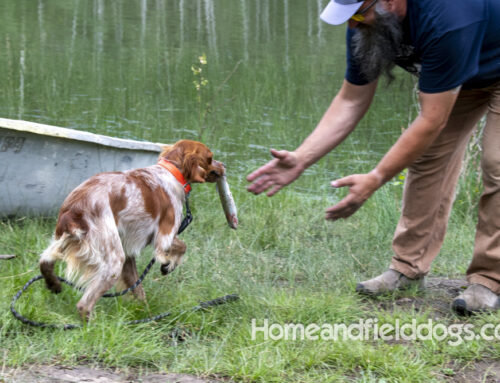Snake avoidance training…. I have hesitated to write this article my whole career. I hate answering this question for people because it is such a high stakes issue. I am also a reptile lover and especially snakes. I have kept countless snakes over the years.
I myself have been rattlesnake bit 3 times. Two were dry bites, the third happened in front of my 8 year old son in the remote wilderness and was really bad.
Let me start by saying there is a rattlesnake vaccine for over 20 years now, and I used to really be a believer in it. However many Vets are not, and it is developed for the western Diamond back rattlesnake, and showed limited effectiveness against other rattlesnakes and does nothing to help with other venomous snakes around the country. But because the negative side effects are relatively insignificant, and the vaccine is affordable, I advise people to get it. It isn’t going to hurt anything and could potentially help. I vaccinated all of my SAR dogs for years because if all it does is buy me time to get to a vet for care, then it has done its job. Also keep Benadryl with you (that is covered in our first aid kit article) and know the dosage for your dog. I have been fortunate I have not had my dogs bit ever, but I still don’t want to take chances. When it was first advertised it was said it would be as effective as two doses of antivenom. Most Vets will tell you that isn’t what they have seen but there are many anecdotal stories out there of dogs who were vaccinated and had fewer complications from the bites. Lastly I believe even though it was designed for the Western Diamondback, if it strengthens the immune system in any way at all, and if it can lessen the histamine reaction from other venoms because of this, why wouldn’t you do it just in case?
We have French Brittanys from Home and field dogs that have been placed all over the country and might encounter coral snakes or copper heads or cottonmouths. We don’t want any of our beloved dogs to ever encounter venomous snakes, let alone have close contact with one.
So here is the dilemma; Don’t teach your dog snake avoidance, and it may be bit and potentially die. This is a horrible possibility. Train your dog for snake avoidance and accept that it may actually ruin your dog for field work, and it is a brutal process.
French Brittany dogs are a “soft” breed. They are sweet and lovable and biddable. They are trusting and bonded. Snake avoidance training is a negative reinforcement only type of training that uses pain and fear to teach a dog to avoid snakes. Different trainers have different methods and varying degrees of qualification and success. I would not trust another trainer to put my dogs through snake avoidance training and I don’t have the heart to do it myself. I have worked with venomous snakes throughout my life and have many friends with all the proper permits. I am also a great dog trainer, so I could set up some classes and do this I just hate the process. I also hate the possibilities of not doing it.
One method is to use snakes that have been “defanged” a fancy term for someone broke their teeth out with a set of pliers and is an idiot, or snakes that have had the venom glands removed surgically (good luck finding a Vet that will perform that surgery) and letting the snakes actually bite the dogs causing fear and pain and the possibility of infected puncture wounds and other injuries.
Another method is placing the snakes where they can’t quite get to the dogs but the dogs can see them, smell them and hear them. When the dogs get close they are given shocks or other negative reinforcers until you can’t get the dog to go near a snake. The outcome is great, but the process is horrible especially for these soft dogs. Especially if they associate you with the process in anyway, which means you have to trust someone else to do it.
So I have been a chicken all these years. I have simply managed the risk. Here in the West I hunt usually after snakes have gone into hibernation or are extremely lethargic due to colder temperatures, or I avoid areas where I am sure to come across them. For summer training I use areas that are likely to be free of Rattlesnakes. Is this one hundred percent effective? No but it is a level of risk I have always been comfortable with.
Utah now allows the legal collection and possession of native rattlesnakes if you jump through a few hoops, so perhaps it is time I legally possess some and offer snake courses? Who would be interested?
Venomous Snake Avoidance Training for French Brittany Dogs: A Comprehensive Guide
As a proud pet owner and passionate dog lover, I understand the joy and excitement that comes with owning a French Brittany. These intelligent, energetic, and affectionate dogs make fantastic companions, but they also have a natural curiosity that can sometimes lead them into danger. One such danger is venomous snakes, which can pose a serious threat to your furry friend. That’s why venomous snake avoidance training is essential for keeping your French Brittany safe and sound. In this article, we’ll explore the importance of this training, the benefits it provides, and how it works, as well as offer practical advice on managing the training process and recommendations for helpful products and experts.
Why is Snake Avoidance Training Necessary?
Venomous snakes are found in various regions worldwide, and their bites can cause severe pain, tissue damage, or even death for our beloved pets. French Brittanys, with their keen hunting instincts and boundless energy, are especially at risk of encountering these dangerous creatures while exploring the great outdoors. By teaching your dog to recognize and avoid venomous snakes, you can significantly reduce the risk of a potentially fatal encounter and enjoy peace of mind during your outdoor adventures together.
The Benefits of Snake Avoidance Training
In addition to the obvious life-saving advantage, snake avoidance training helps:
Build your dog’s confidence when navigating unfamiliar territory.
Strengthen the bond between you and your French Brittany through trust and communication.
Improve overall obedience and responsiveness to commands, making other aspects of training more manageable.
How Does Snake Avoidance Training Work?
Snake avoidance training typically involves exposing your dog to live, safely restrained venomous snakes in a controlled environment. Under the guidance of an experienced trainer, your dog will learn to identify the sight, smell, and sound of these snakes and associate them with an unpleasant experience, such as a loud noise or a mild correction from a training collar. This negative association will encourage your dog to avoid snakes in the future.
Challenges and Practical Advice
While snake avoidance training is highly beneficial, it’s not without its challenges. Some pet owners may be hesitant to expose their dogs to live snakes, fearing injury or psychological trauma. However, under the supervision of a skilled trainer, the process can be safe and effective. To ensure a smooth training experience:
Research local trainers and choose one with a proven track record and positive reviews.
Discuss any concerns or questions with your chosen trainer before beginning the training process.
Attend the training sessions with your dog to provide comfort and support.
Training Techniques and Positive Reinforcement
When teaching your French Brittany to avoid venomous snakes, it’s essential to use positive reinforcement techniques. Rewarding your dog with praise, treats, or playtime when they successfully avoid a snake will reinforce the desired behavior and make the training process more enjoyable for both of you.
Identifying Venomous Snakes
It’s crucial to familiarize yourself with the types of venomous snakes native to your area. In North America, for example, you may encounter rattlesnakes, copperheads, cottonmouths, and coral snakes. Learn to recognize their distinctive markings, colors, and behaviors so you can better protect your dog and educate others on snake safety.
Product and Expert Recommendations
To assist with snake avoidance training, consider investing in the following products:
A high-quality training collar that allows for adjustable levels of correction.
A long leash or lead for maintaining control during training sessions.
For expert guidance, seek out reputable trainers who specialize in snake avoidance training. Local wildlife organizations, veterinarians, or dog trainers may be able to recommend experienced professionals in your area.
In conclusion, venomous snake avoidance training is an invaluable investment in your French Brittany’s safety and well-being. By taking the time to educate yourself and your dog about this potential danger, you can enjoy a lifetime of happy, worry-free adventures together. So why wait? Start researching local trainers today and give your French Brittany the protection they deserve!






Leave A Comment